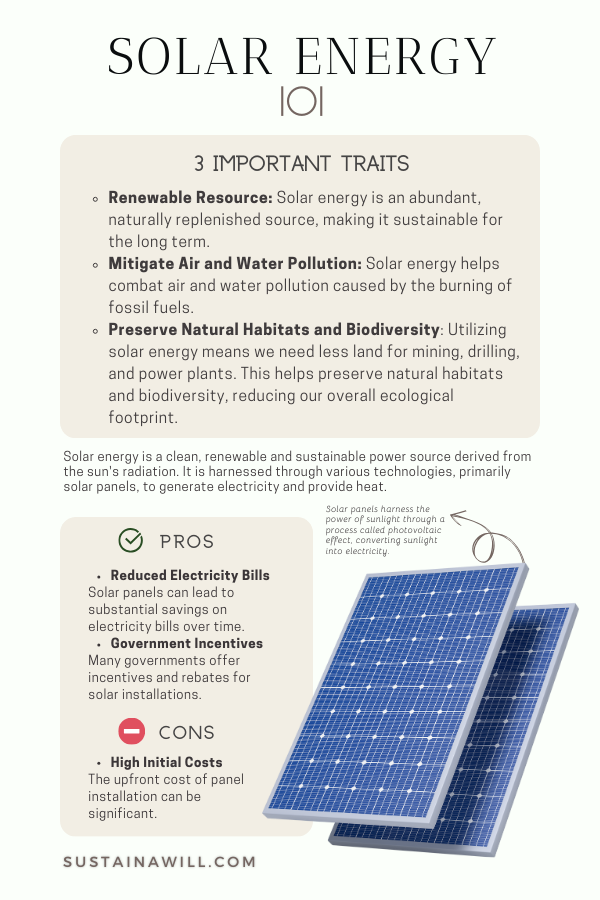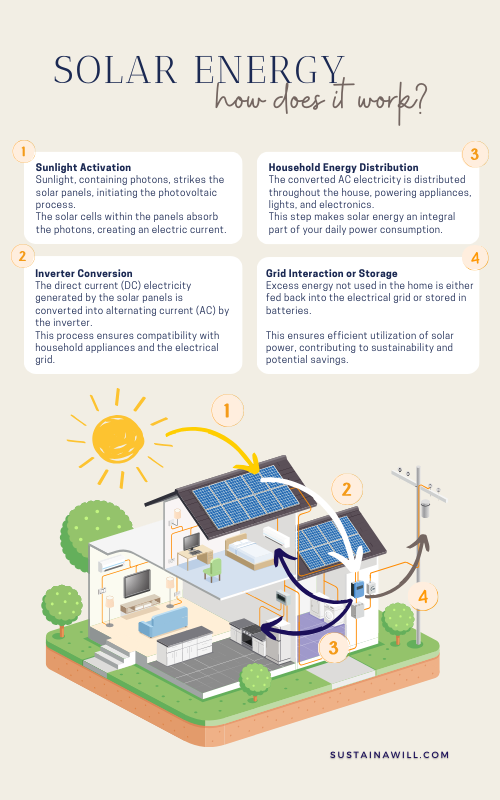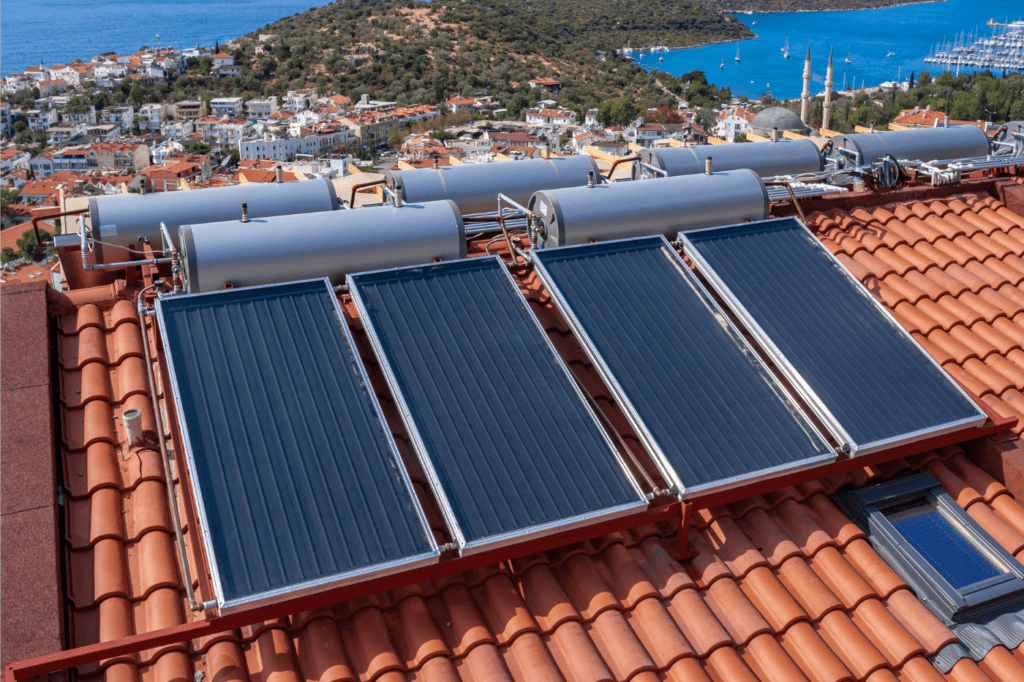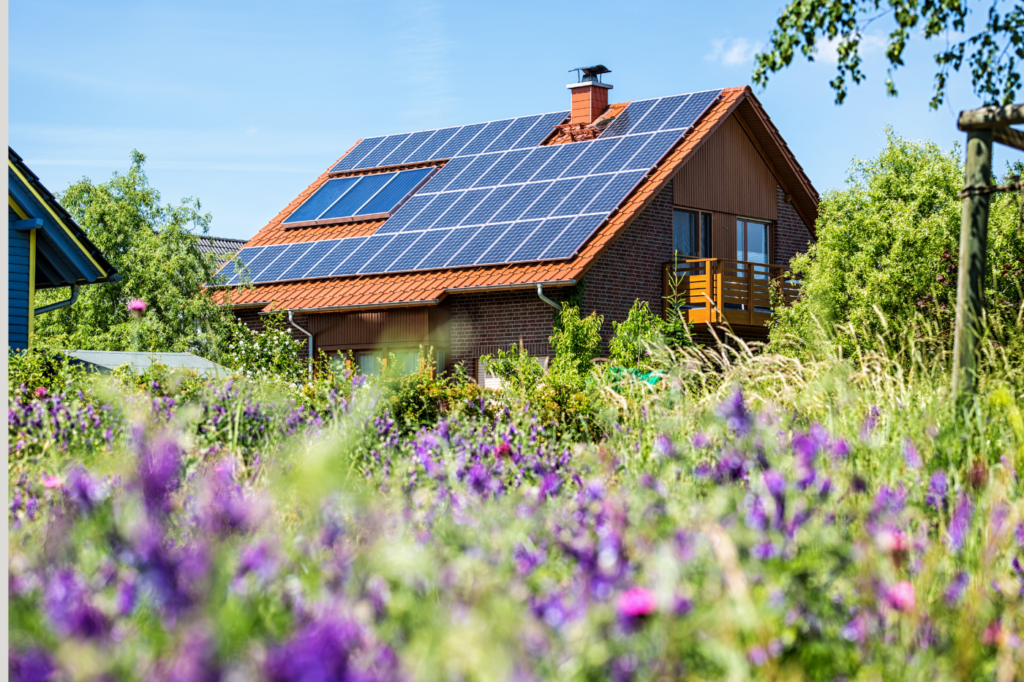Ever wondered how sunlight can power your home and save you money? Welcome to Solar Energy 101: Everything You NEED to Know – your shortcut to understanding the magic of solar!
In the next few scrolls, we will explain how solar works and show you why solar is worth your attention and investment.
Stick around, and by the end, you’ll see sunlight in a whole new light – as a game-changer for your wallet and the planet. Ready to dive into the world of solar energy? Let’s go! ☀️✨
What is the Definition of Solar Energy?
Before we give you a very comprehensive definition of what solar energy is, lets keep things light and start with something easy to digest:
What is Solar Energy in a Sentence?
Solar energy is power derived from the sun’s radiation, harnessed through technologies like solar panels to generate electricity or provide heat.
Broad Definition

Solar energy is a clean, renewable and sustainable power source derived from the sun’s radiation. It is harnessed through various technologies, primarily solar panels, to generate electricity and provide heat. Here’s a breakdown:
- Renewable Resource: Solar energy is an abundant, naturally replenished source, making it sustainable for the long term.
- Captured by Solar Panels: Specialized technologies, like solar panels, capture sunlight and convert it into electricity or heat.
- Versatile Applications: Solar energy powers homes, businesses, and even spacecraft, offering a wide range of practical uses.
- Clean and Environmentally Friendly: Unlike fossil fuels, solar energy production doesn’t emit harmful pollutants, contributing to a greener planet.
- Reduced Energy Bills: Utilizing solar power can significantly cut electricity costs, providing economic benefits to homeowners and businesses.
Historical Journey:
- Ancient Roots: The use of solar energy dates back to ancient civilizations, where structures were designed to capture and utilize sunlight for warmth.
- 19th Century Advances: In the 19th century, scientists made significant strides in understanding solar radiation, laying the groundwork for future solar technologies.
- 20th Century Breakthroughs: The mid-20th century witnessed the development of solar cells, paving the way for solar panels and their use in powering satellites.
- Contemporary Boom: Over the last few decades, technological advancements and growing environmental awareness have fueled a widespread adoption of solar energy for residential, commercial, and industrial purposes.
How Do Solar Panels Work?

Solar panels harness the power of sunlight through a process called photovoltaic effect, converting sunlight into electricity.
Here’s a step-by-step breakdown with additional technical insights:
1. Photons from Sunlight
When sunlight reaches the solar panels, it consists of tiny packets of energy called photons.
Technical Insight: Photons carry energy corresponding to their frequency, and solar panels are designed to capture specific ranges of photon energy.
2. Photon Absorption
Solar panels are made up of photovoltaic cells, typically composed of silicon. When photons strike these cells, they are absorbed.
Technical Insight: The semiconductor properties of silicon allow it to absorb photons and release electrons, creating an electron-hole pair.
3. Electron Excitation
The absorbed energy excites the electrons that sit in the silicon cells, causing them to become energized.
Technical Insight: This energization elevates electrons to a higher energy state within the semiconductor material (typically silicon in solar cells), creating a charge separation.
The elevation of electrons to a higher energy state occurs through a process known as the photoelectric effect.
Here’s a simplified explanation:
- Photon Absorption: When sunlight (composed of photons) strikes the semiconductor material, the photons transfer their energy to electrons in the material.
- Energy Transfer: The energy from the photons is absorbed by the electrons, causing them to move from a lower energy state to a higher one.
- Creation of Electron-Hole Pairs: As electrons move to a higher energy state, they leave behind “holes” in the lower energy state. This creates electron-hole pairs, which are essential for generating an electric current.
- Charge Separation: The energized electrons and the holes created by their absence create a charge separation, resulting in an electric field within the semiconductor material.
- Facilitating Electron Flow: The electric field propels the energized electrons, allowing them to move through the semiconductor material, generating an electric current.
In summary, the photoelectric effect is the fundamental process by which photons transfer their energy to electrons in a material, elevating them to a higher energy state and creating the conditions for the generation of electricity in solar cells.
4. Electron Flow
The energized electrons create an electric current, flowing within the solar cell.
Technical Insight: The movement of these energized electrons constitutes an electric current, generating a flow of electricity within the cell.
5. Direct Current (DC) Electricity
The generated electric current is in the form of direct current (DC).
Technical Insight: Direct current is a continuous flow of electric charge in one direction, maintaining a constant voltage.
6. Inverter Conversion
An inverter converts the DC electricity into alternating current (AC), the type of electricity used in homes and businesses.
Technical Insight: Inverters utilize electronic switches to change the direction of current flow, ensuring compatibility with the standard alternating current grid.
Read more in-depth info about the difference between AC and DC here.
7. Power Distribution
The converted AC electricity is then ready for use, either powering appliances directly or feeding into the electrical grid.
Technical Insight: AC electricity’s ability to change direction allows it to be efficiently distributed over long distances, minimizing energy loss during transmission.
What are 5 Examples of Solar Energy?

Harnessing the power of the sun has led to innovative applications across various sectors.
Here are five examples showcasing the versatility of solar energy:
- Solar Photovoltaic (PV) Systems:
- Transforming sunlight into electricity, solar panels in PV systems offer a clean and sustainable energy solution, commonly seen on rooftops and in solar farms.
- Solar Water Heating Systems:
- Reducing reliance on traditional water heaters, solar water heating systems use sunlight to warm water for homes and businesses, promoting energy efficiency.
- Solar Air Conditioning:
- Embracing sustainability, solar-powered air conditioning systems utilize the sun’s energy to cool buildings, providing an eco-friendly alternative to traditional cooling methods.
- Solar-Powered Vehicles:
- In the realm of transportation, solar panels integrated into electric vehicles and hybrids enable them to harness sunlight for charging, extending their range and promoting greener commuting.
- Solar-Powered Outdoor Lighting:
- Illuminating our streets and outdoor spaces, solar-powered lighting systems use photovoltaic cells to collect solar energy during the day, ensuring efficient and sustainable lighting at night.
The Importance of Solar Energy

Solar energy holds immense significance in today’s world for several compelling reasons:
- Renewable and Sustainable: Solar energy is a renewable resource, providing an everlasting and sustainable power source that doesn’t deplete over time.
- Reduced Environmental Impact: Harnessing solar power produces minimal environmental pollutants, contributing to a cleaner and greener planet by reducing carbon emissions and air pollution.
- Energy Independence: Solar energy reduces dependence on finite fossil fuels, enhancing energy security and mitigating geopolitical risks associated with traditional energy sources.
- Cost-Effective and Scalable: Advancements in technology have made solar energy increasingly cost-effective, with the potential for mass scalability, making it accessible for both individuals and large-scale industries.
- Job Creation: The solar industry fosters job creation, from research and development to installation and maintenance, providing employment opportunities and stimulating economic growth.
- Versatility in Applications: Solar energy can be harnessed for various applications, including electricity generation, water heating, air conditioning, and powering vehicles, showcasing its versatility and adaptability.
- Resilience in Remote Areas: Solar power is instrumental in providing electricity to remote and off-grid areas, offering a reliable energy source where traditional infrastructure may be impractical or cost-prohibitive.
- Technological Advancements: Ongoing innovations in solar technology continue to improve efficiency, storage capabilities, and overall performance, ensuring a promising and evolving energy solution.
- Climate Change Mitigation: Utilizing solar energy helps mitigate the impact of climate change by reducing the reliance on fossil fuels, which are major contributors to global warming and climate-related challenges.
- Empowering Communities: Solar energy empowers individuals and communities by providing a decentralized energy source, enabling greater self-sufficiency and resilience in the face of energy challenges.
Read more about the pros and cons of solar here.
In essence, the importance of solar energy lies in its ability to address environmental concerns, promote sustainable development, and contribute to a cleaner, more resilient energy future for the world.
FAQs – Everything You Wondered about Solar Energy
How Do Solar Panels Work?
Solar panels convert sunlight into electricity through photovoltaic cells, which harness the energy from photons to create an electric current.
Are Solar Panels Efficient in Cloudy Weather?
Yes, solar panels still generate power in cloudy conditions, although their efficiency is reduced compared to sunny days.
What Happens on Rainy Days or at Night?
Solar panels don’t generate electricity at night. However, excess energy produced during the day can be stored in batteries or drawn from the grid when needed.
How Long Do Solar Panels Last?
Solar panels have a lifespan of 25-30 years or more, with gradual declines in efficiency over time.
What Size Solar System Do I Need for My Home?
The size of the solar system depends on your energy consumption. A professional assessment can determine the optimal size for your needs.
Can I Use Solar Power During a Power Outage?
Yes, if you have a solar battery storage system. Traditional grid-tied systems shut down during outages for safety reasons.
How Much Money Can I Save with Solar Panels?
Savings depend on factors like energy consumption, system size, and local incentives. On average, homeowners can save thousands over the system’s lifetime.
What Is Net Metering?
Net metering allows you to sell excess solar energy back to the grid, offsetting your electricity costs and potentially earning credits.
Do Solar Panels Require a Lot of Maintenance?
Solar panels are low-maintenance. Regular cleaning and occasional checks by professionals ensure optimal performance.
Are Solar Panels Environmentally Friendly?
Yes, solar panels are eco-friendly as they produce clean energy without emitting greenhouse gases, reducing your carbon footprint.
These FAQs provide insights into common queries about solar energy, empowering you with the knowledge to make informed decisions about adopting this sustainable power source.
Conclusion: Go Solar, Power Your Future
In exploring Solar Energy 101, you’ve glimpsed a cleaner, sustainable future. Now, with rising energy costs, environmental concerns, and grid vulnerabilities, the choice is clear. Imagine a world where your home generates power, your commute is green, and energy bills vanish.
The choice is yours, will you light up your future with solar energy? 🌞✨








